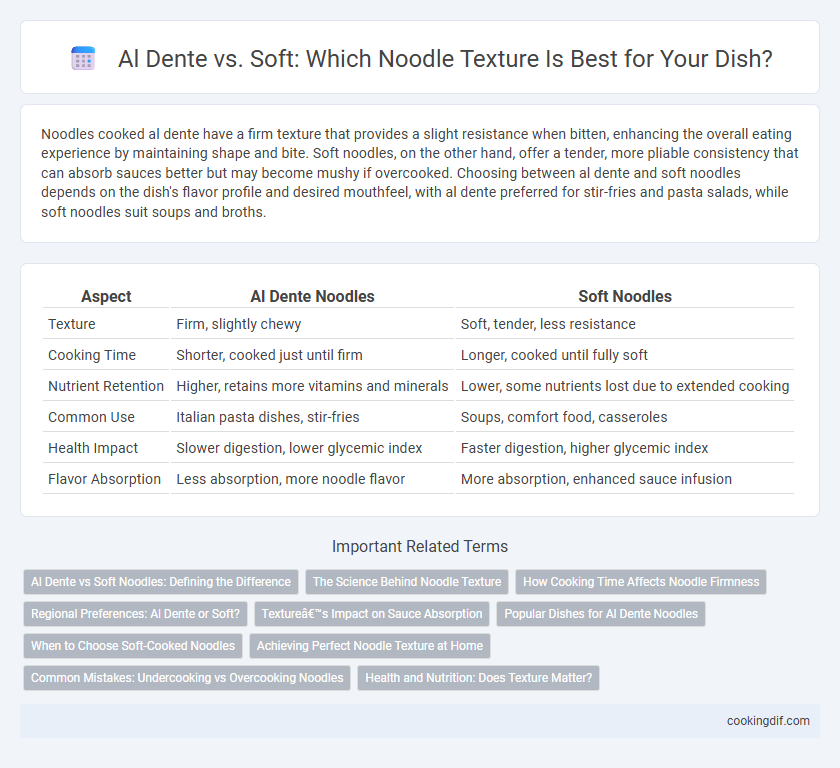Noodles cooked al dente have a firm texture that provides a slight resistance when bitten, enhancing the overall eating experience by maintaining shape and bite. Soft noodles, on the other hand, offer a tender, more pliable consistency that can absorb sauces better but may become mushy if overcooked. Choosing between al dente and soft noodles depends on the dish's flavor profile and desired mouthfeel, with al dente preferred for stir-fries and pasta salads, while soft noodles suit soups and broths.
Table of Comparison
| Aspect | Al Dente Noodles | Soft Noodles |
|---|---|---|
| Texture | Firm, slightly chewy | Soft, tender, less resistance |
| Cooking Time | Shorter, cooked just until firm | Longer, cooked until fully soft |
| Nutrient Retention | Higher, retains more vitamins and minerals | Lower, some nutrients lost due to extended cooking |
| Common Use | Italian pasta dishes, stir-fries | Soups, comfort food, casseroles |
| Health Impact | Slower digestion, lower glycemic index | Faster digestion, higher glycemic index |
| Flavor Absorption | Less absorption, more noodle flavor | More absorption, enhanced sauce infusion |
Al Dente vs Soft Noodles: Defining the Difference
Al dente noodles are cooked to be firm to the bite, retaining a slight resistance that enhances texture and flavor absorption, while soft noodles are cooked longer until tender and fully softened, offering a smoother, more pliable mouthfeel. The al dente texture is preferred in Italian cuisine for pasta dishes like spaghetti and fettuccine because it maintains shape and provides a satisfying chew. Conversely, soft noodles are commonly used in soups and Asian dishes where a delicate, melt-in-the-mouth consistency complements the broth or sauce.
The Science Behind Noodle Texture
Noodle texture is determined by the gelatinization of starch and the denaturation of proteins during cooking, with al dente noodles having a firmer structure due to incomplete starch gelatinization. Soft noodles result from extended cooking times, leading to full starch gelatinization and increased water absorption, which weakens the noodle's matrix. The balance between amylose and amylopectin in the flour also influences texture, as higher amylose content promotes firmness and resistance to overcooking.
How Cooking Time Affects Noodle Firmness
Cooking time directly impacts noodle firmness by controlling the water absorption and starch gelatinization process within the pasta. Al dente noodles, cooked for a shorter time, retain a firmer, slightly resistant texture due to less water penetration and a denser gluten network. Longer cooking results in softer noodles as starch granules swell more fully and proteins weaken, producing a tender, pliable consistency.
Regional Preferences: Al Dente or Soft?
Regional preferences for noodle texture vary significantly, with Italian cuisine favoring al dente for its firm, slightly resistant bite that enhances pasta dishes' overall structure. In contrast, many Asian cultures prefer soft noodles that absorb sauces and broths more thoroughly, creating a tender and comforting mouthfeel. These preferences reflect local cooking styles and traditional flavor profiles, influencing how noodles are prepared and enjoyed globally.
Texture’s Impact on Sauce Absorption
Al dente noodles have a firm texture that resists over-absorption, allowing sauces to cling to their surface effectively, enhancing flavor distribution. In contrast, softer noodles absorb more sauce, which can dilute the intended taste and create a mushy consistency. Choosing al dente texture improves sauce retention and delivers a balanced, satisfying bite in every mouthful.
Popular Dishes for Al Dente Noodles
Al dente noodles retain a firm texture that enhances popular dishes like Italian pasta, stir-fried noodles, and ramen, providing a satisfying bite that complements rich sauces and fresh ingredients. This texture is favored in recipes such as Spaghetti Carbonara and Pad Thai, where the noodles maintain structure and absorb flavors without becoming mushy. Cooking noodles al dente ensures the dish achieves the ideal balance between tenderness and chewiness, elevating the overall dining experience.
When to Choose Soft-Cooked Noodles
Soft-cooked noodles are ideal for recipes like soups, casseroles, or stir-fries where the noodles continue to cook after initial boiling, absorbing flavors and creating a tender texture. This texture enhances dishes such as chicken noodle soup or lo mein, providing a gentle bite that complements broth and sauce consistency. Opting for soft noodles is essential in dishes requiring prolonged cooking or significant ingredient mixing to achieve a harmonious, melded flavor profile.
Achieving Perfect Noodle Texture at Home
Achieving the perfect noodle texture at home relies on understanding the difference between al dente and soft noodles, where al dente offers a firm, slightly chewy bite while soft noodles provide a tender, easily breakable consistency. Cooking time and water temperature are key factors, with al dente noodles typically boiled for 1-2 minutes less than the package instructions and tested frequently to maintain their firmness. Using high-quality durum wheat semolina or egg noodles, combined with precise timing and immediate cold water rinsing, ensures optimal texture tailored to personal preference.
Common Mistakes: Undercooking vs Overcooking Noodles
Undercooking noodles leaves them hard and starchy, causing an unpleasant chewy texture that lacks the desired elasticity of al dente pasta. Overcooking results in mushy, overly soft noodles that fall apart easily and lose their structural integrity. Achieving the perfect al dente texture requires precise timing to ensure noodles are tender yet firm to the bite, avoiding common errors in both undercooking and overcooking.
Health and Nutrition: Does Texture Matter?
Al dente noodles retain more resistant starch, which supports digestive health and stabilizes blood sugar levels, compared to soft noodles that have a higher glycemic index. The firmer texture also preserves more nutrients, such as B vitamins and minerals, often lost during overcooking. Choosing al dente noodles can enhance satiety and aid in weight management by slowing carbohydrate absorption.
Al dente vs soft for noodle texture Infographic

 cookingdif.com
cookingdif.com